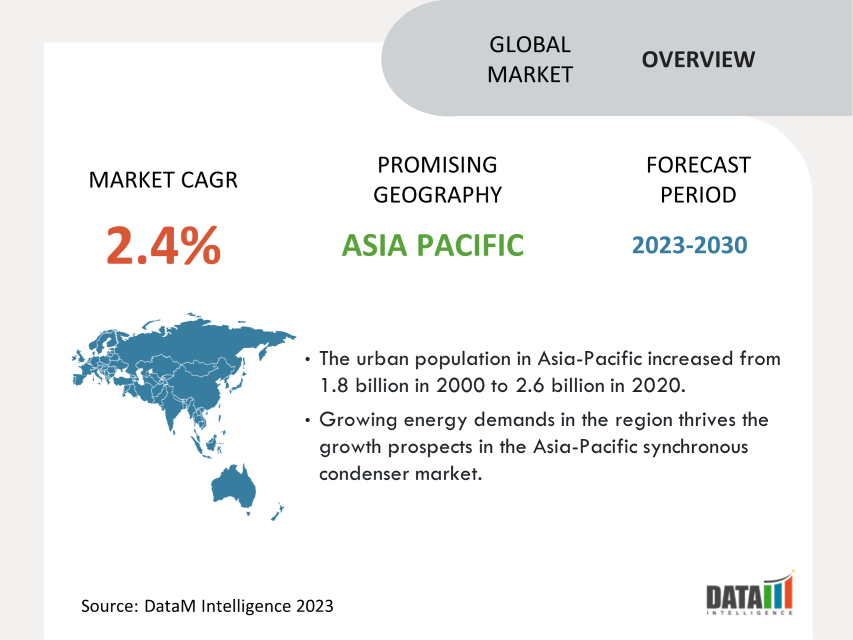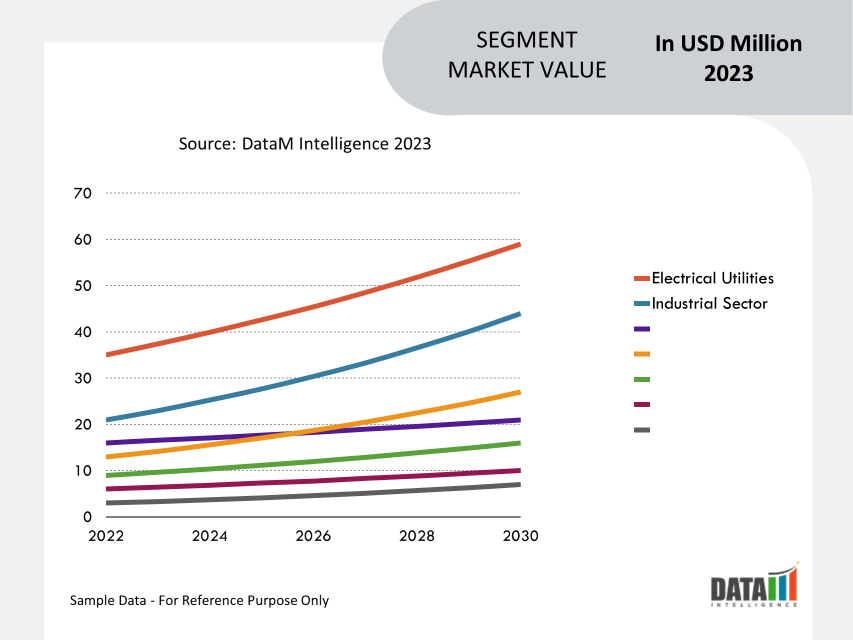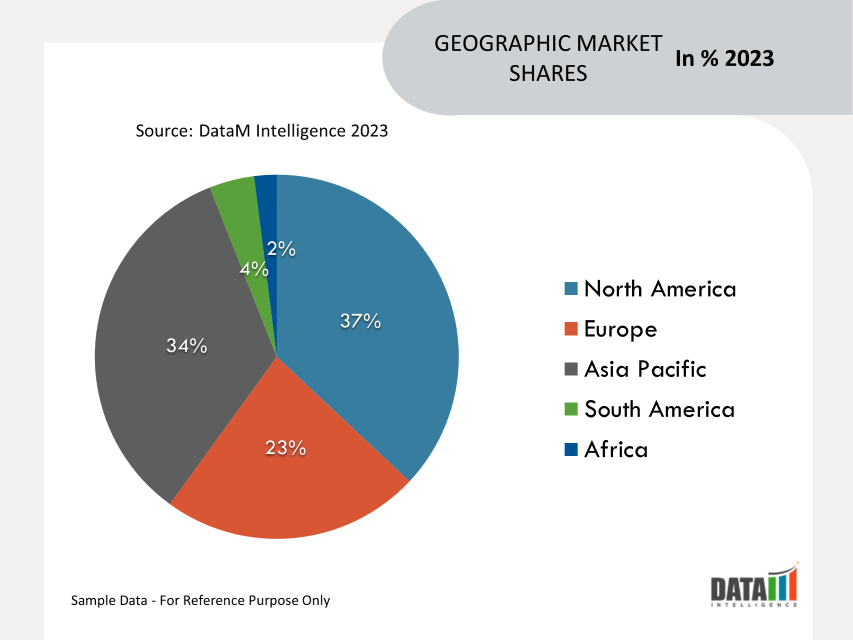Global Synchronous Condenser Market is segmented By Insulation (New Synchronous Condenser, Refurbished Synchronous Condenser), By Cooling Technology (Hydrogen-Cooled, Air-Cooled, Water-Cooled), By Reactive Power Rating (Up to 10 MVAr, 101 to 200 MVAr, Above 200 MVAr), By End-User (Electrical Utilities, Industrial Sector), and By Region (North America, Latin America, Europe, Asia Pacific, Middle East, and Africa) – Share, Size, Outlook, and Opportunity Analysis, 2023 - 2030
Synchronous Condenser Market Overview
Global synchronous condenser market reached USD 635.2 million in 2022 and is expected to reach USD 769.4 million by 2030, growing with a CAGR of 2.4% during the forecast period 2023-2030. The need for reactive power compensation from electric utilities, such as transmission systems, power plants and other industrial applications, is growing.
In the upcoming years, it is projected that benefits related to synchronous condensers, such as power factor correction, reactive power compensation, grid stability and voltage regulation, would further propel the market's expansion.
To maintain their position as market leaders in the synchronous condenser sector, major competitors in Europe are implementing a variety of methods, including agreements and collaboration.
For instance, in December 2020, Elering AS, an Estonian transmission system operator and Siemens Energy signed a contract. The construction of three synchronous condenser facilities in Estonia was the goal of this agreement. With the help of this, Siemens Energy will design, provide and install the three 330 kV synchronous condenser plants that will be built in the northern Estonian towns of Püssi, Viru and Kiisa. Therefore, Europe holds for 1/3 rd of the global market share.

Synchronous Condenser Market Scope
| Metrics | Details |
| CAGR | 2.4% |
| Size Available for Years | 2021-2030 |
| Forecast Period | 2023-2030 |
| Data Availability | Value (US$) |
| Segments Covered | Insulation, Cooling Technology, Reactive Power Rating, End-User, and Region |
| Regions Covered | North America, Europe, Asia-Pacific, South America and Middle East & Africa |
| Largest Region | North America |
| Report Insights Covered | Competitive Landscape Analysis, Company Profile Analysis, Market Size, Share, Growth, Demand, Recent Developments, Mergers and Acquisitions, New Equipment Insulation Launches, Growth Strategies, Revenue Analysis, Porter’s Analysis, Pricing Analysis, Regulatory Analysis, Supply-Chain Analysis and Other key Insights. |
For More Insights about the Market Request Free Sample
Synchronous Condenser Market Dynamics
Growing Demand for Clean Energy Source
The global market for synchronous condensers is expanding as a result of the rising need for renewable energy sources. Clean energy sources like wind and solar power are gaining popularity as the world moves towards a more sustainable and eco-friendly energy landscape. Voltage management and grid stability are two issues that arise when integrating these inconsistent renewable energy sources.
For instance, in Macrh 28, 2023, For Statkraft, ABB has finished a significant turnkey project that will assist replenish the system inertia that is necessary for the reliable running of UK power grid. This is crucial as the country transitions away from fossil fuels and increases its usage of renewable energy sources like wind and solar. Two ABB high-inertia synchronous condenser systems were installed as part of the project at the Liverpool Lister Drive Greener Grid Park. They are currently operating and provide about 1% of the UK's anticipated inertia needs until 2025.
Grid Modernization and Upgradation
The primary objective of grid modernization is to make the system more resilient to disruptive events like cyberattacks, natural disasters and harsh weather. Synchronous condensers can react quickly to shifts in the demand or supply for power, supporting the grid in times of crisis and system contingencies. Synchronous condensers strengthen grid resilience and raise their demand in contemporary power systems by assisting with grid stability and minimizing downtime during emergencies.
For instance, in August 30, 2022, Siemens Energy has been contracted by the German-Dutch grid operator TenneT to provide three grid stabilization systems for the German electricity grid. Conventional power plants not only produce electricity but also automatically stabilize the grid due to their physical behavior, requiring the need for such solutions.
Technological Competition
Alternative grid stabilization methods, such as static VAR compensators (SVCs) and static synchronous compensators (STATCOMs), compete with synchronous condensers. Due to their unique benefits or cost-effectiveness, some grid operators may choose these options over synchronous condensers since they also provide reactive power support and voltage regulation capabilities.
Synchronous condensers can have somewhat greater upfront costs and ongoing expenses than certain alternative technologies. Cost concerns may cause grid operators and utilities to select grid stabilization technologies that are more economically feasible, which could have an impact on the development of the synchronous condenser industry.
Synchronous Condenser Market Segment Analysis
The global synchronous condenser market is segmented based on insulation, cooling technology, reactive power rating, end-user and region.
Rising Demand for Grid Infrastructure and Electric Vehicles Drives Segmental Growth
Due to the increase in demand for grid infrastructure-supporting items like electricity, the electrical utilities category grew to have the biggest market share in 2022. Additionally, the increasing uptake of electric vehicles has increased the number of charging stations, which serves as a major driver of growth and opens up new possibilities for the integration of renewable electricity in charging stations.
By absorbing or producing reactive power as needed in these stations, synchronous condensers can be employed to increase power factor. In the coming years, it is also projected that this would increase demand for synchronous condensers. Therefore, electrical utilities segment is expected to hold majority of the market share during the freocast period.

Synchronous Condenser Market Geographical Share
Growing Demand for Power and Grid Upgrades in the U.S.
Due to population expansion, urbanization and industrial operations, U.S. has a rising demand for power. Due to the increased demand for electricity, grid upgrades and investments in grid stabilization technologies are necessary, which opens up the potential for the use of synchronous condensers.
On February 21, 2023, Quinbrook, U.S. will spend more than GBP 200 million developing essential grid infrastructure in Scotland and facilitating a secure energy transition. Quinbrook will spend more than GBP 200 million developing essential grid infrastructure in Scotland, producing over 550 jobs and facilitating a secure energy transition. Therefore, U.S. dominates the North American synchronous condenser market with more than 75.5% of the market share.

Synchronous Condenser Market Companies
The major global players include Eaton Corporation plc, Voith GmbH & Co. KGaA, ABB LTD, GENERAL ELECTRIC, Ideal Electric Power Co., Fuji Electric, Siemens Energy, Mitsubishi Electric Corporation, Andritz and WEG Group.
COVID-19 Impact Analysis
Similar to many other industries, the COVID-19 epidemic had an effect on the global synchronous condenser companies. The pandemic caused supply chains to become disrupted, industrial and construction activity to decline and investment decisions to become unclear, all of which had an impact on the demand for and production of synchronous condensers.
The pandemic caused travel and trade restrictions, which had an impact on the supply chain for the raw materials and parts required to make synchronous condensers. Potential project delays were caused by delays in transportation and logistics that prevented equipment from being delivered on time.

Russia-Ukraine War Impact Analysis
Energy prices have an indirect impact on synchronous condensers, which are utilized in power systems for grid stability and voltage management. Any aggravation of the conflict between Russia and Ukraine might potentially cause interruptions in energy supply and transportation, which would have an impact on world energy markets. Such interruptions might enhance the emphasis on grid stability and reliability in areas that are strongly dependent on energy imports, possibly increasing the demand for grid stabilization technologies like synchronous condensers.
By Insulation
- New Synchronous Condenser
- Refurbished Synchronous Condenser
By Cooling Technology
- Hydrogen-Cooled
- Air-Cooled
- Water-Cooled
By Reactive Power Rating
- Up to 10 MVAr
- 101 to 200 MVAr
- Above 200 MVAr
By End-User
- Electrical Utilities
- Industrial Sector
By Region
- North America
- U.S.
- Canada
- Mexico
- Europe
- Germany
- UK
- France
- Italy
- Russia
- Rest of Europe
- South America
- Brazil
- Argentina
- Rest of South America
- Asia-Pacific
- China
- India
- Japan
- Australia
- Rest of Asia-Pacific
- Middle East and Africa
Key Developments
- On May 15, 2023, The synchronous compensator, which is required to detach the energy grid from the Russian network and connect it to the continental European grid, has been launched by Elering. This synchronous condenser (SynCon) is the first of three that will be constructed in Estonia.
- In September 2021, An order to supply the electro-mechanical components for four synchronous condenser plants in New South Wales has been placed with the international technology company ANDRITZ by SecureEnergy.
- In January 2022, The German company will build three synchronous condensers in Estonia by 2024 after submitting the lowest bid for the tender from Estonian transmission network operator Elering. In Püssi, construction has already begun on the first device.
Why Purchase the Report?
- To visualize the global synchronous condenser market segmentation based on insulation, cooling technology, reactive power rating, end-user and region, as well as understand key commercial assets and players.
- Identify commercial opportunities by analyzing trends and co-development.
- Excel data sheet with numerous data points of synchronous condenser market-level with all segments.
- PDF report consists of a comprehensive analysis after exhaustive qualitative interviews and an in-depth study.
- Product mapping available as Excel consisting of key products of all the major players.
The global synchronous condenser market report would provide approximately 69 tables, 63 figures and 211 Pages.
Target Audience 2023
- Manufacturers/ Buyers
- Industry Investors/Investment Bankers
- Research Professionals
- Emerging Companies
